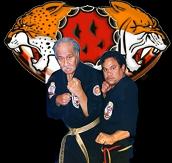|
Also known as Lima Lama, is an
American-Samoan martial arts system. The term Limalama is translated as “The
Hand of Wisdom”.Limalama was created and founded by Tu'umamao "Tino"
Tuiolosega in the mid-50s. Tino Tuiolosega was born in Tutilia, American
Samoa on July 2, 1931 and is the only son of King Tu'umamao Tuiolosega and
Saposapoaluga Feagai Poumele Tuiolosega. His grandfather Tagaloa Tuiolosega
was the last King of all the islands of Samoa before it was divided and
American Samoan became part of the U.S. Territory. |
 |
|
Being the son of a royal
family he was required to learn numerous combative techniques of self
defense passed down from his father and uncle. This gave him a basis for
understanding how body and mind work together as one and merging the
concepts with his modern knowledge and skill as a boxer and respected street
fighter, he developed a system of martial arts with techniques and forms
that maximize an individual's ability. In the 1950s and 1960s he achieved
Master Ranks in the five animal styles of Sil-lum Kung fu. In the 1960s, he
received a shodan in American Kenpo from Ed Parker.
Development
Limalama is a contemporary martial arts system with roots in ancient
fighting techniques. Tino brought Limalama from Samoa to Hawaii and later to
Los Angeles in the mid-60s and gained a reputation as one of the most feared
competitors of his time. During the 50's formal tournaments were nonexistent
and much of his reputation was built on his infamous street matches having
defeated the number one street fighter in Oahu, Hawaii people took notice of
his aggressive fighting techniques and ruthless unrehearsed demonstrations.
He enlisted in the Marine Corp in 1950 and participated in the Inchon
landing, receiving a bronze star and a purple heart. He continued developing
Limalama and taught hand to hand combat not only for the Marines but also
Naval personnel and also participated in boxing and judo matches. As an
amateur boxer, he fought over 135 fights, winning 108 by knockout. Some of
his titles include All Pacific Inter-School boxing Conference, All Far East,
All Pacific Inter-Service, All Armed Forces, Pan Pacific, All Martine,
Fourteen Naval District, AAU, and Eleventh District Championships. During
the 50's formal martial arts tournaments were nonexistent and much of his
reputation was built on street matches and in particular beating the number
one gang leader in Oahu, Hawaii.
Parentage
Roots of the System
1. Afitau – the study of warrior's traditions, specifically dance.
2. Amofoe – the understanding of the manipulation of weights, shifting and
swaying tactics to off balance weight.
3. Fa’aelise – the study of coordination, reflexes, balance, holds, breaks
and throws.
4. Fa’ato’elau – movements similar to wrestling, including holds and
tripping.
5. Faufusu or Tu’itu’iga – movements similar to hand to hand fighting,
boxing or street fighting.
6. Lua’aga or Le’iga – the study of pressure points, nerves and joints.
7. Milosia – the study of the execution, delivery and application of
circular movements; such as locking wrists.
8. Pepelu ma Pega – the study of knife fighting, this is a cutting
coordination. This is a conceptual method in the use of weaponry.
9. Uma Ma Taupi'i – the study of holds, breaks and take downs.
10. Vaeta ma Tavae – the study of foot movements such as kicks and foot
counter movements.
11. Ti’apega ma Lo’u – the study of Kaoi'a, stick fighting.
12. Talamoa – the study of combining several of the other concepts together.
13. Upega ma Lo’ulo’uga – the study of trapping.
Limalama’s distinguishing characteristic is its grounding in historical
Samoan/Polynesian martial arts – including wrist lays, hand-traps, and bone
dislocation and breaking, along with knife and stick techniques. The art has
a wide following in South and Central America with several divergent
branches from the original style. There are also a number of schools active
in the United States and Europe. |













